ESP YAMAHA DT125R 2002 Owners Manual
[x] Cancel search | Manufacturer: YAMAHA, Model Year: 2002, Model line: DT125R, Model: YAMAHA DT125R 2002Pages: 96, PDF Size: 2.14 MB
Page 26 of 96
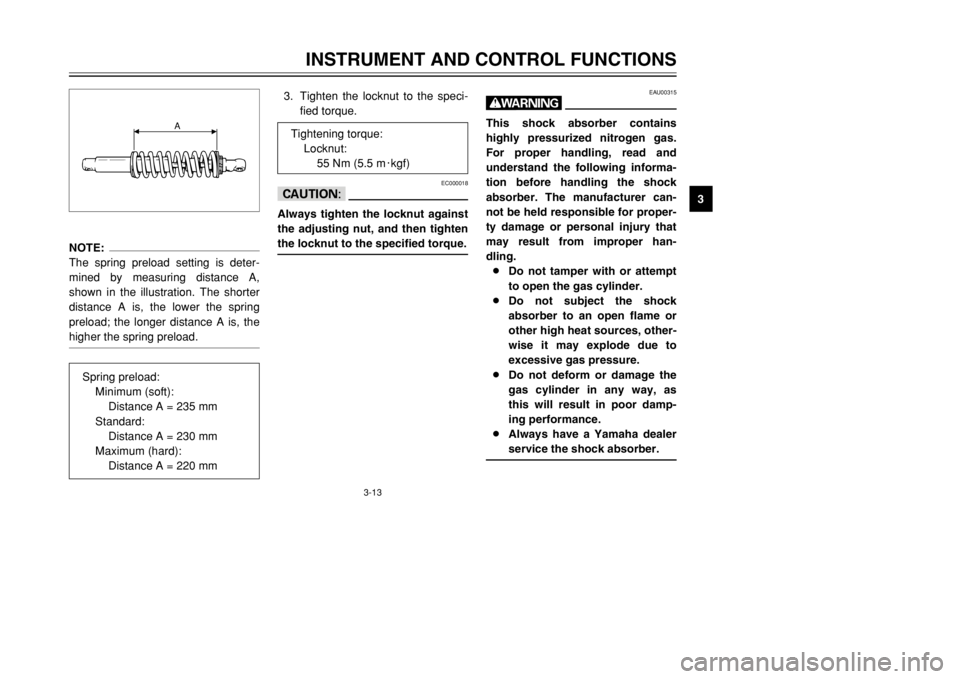
3-13
INSTRUMENT AND CONTROL FUNCTIONS
3 3. Tighten the locknut to the speci-
fied torque.
EC000018
cCAlways tighten the locknut against
the adjusting nut, and then tighten
the locknut to the specified torque.
EAU00315
wThis shock absorber contains
highly pressurized nitrogen gas.
For proper handling, read and
understand the following informa-
tion before handling the shock
absorber. The manufacturer can-
not be held responsible for proper-
ty damage or personal injury that
may result from improper han-
dling.
8Do not tamper with or attempt
to open the gas cylinder.
8Do not subject the shock
absorber to an open flame or
other high heat sources, other-
wise it may explode due to
excessive gas pressure.
8Do not deform or damage the
gas cylinder in any way, as
this will result in poor damp-
ing performance.
8Always have a Yamaha dealer
service the shock absorber.
NOTE:
The spring preload setting is deter-
mined by measuring distance A,
shown in the illustration. The shorter
distance A is, the lower the spring
preload; the longer distance A is, the
higher the spring preload.
A
Spring preload:
Minimum (soft):
Distance A = 235 mm
Standard:
Distance A = 230 mm
Maximum (hard):
Distance A = 220 mm
Tightening torque:
Locknut:
55 Nm (5.5 m0kgf)
3MB-9-E8 6/13/01 10:55 AM Page 25
Page 28 of 96
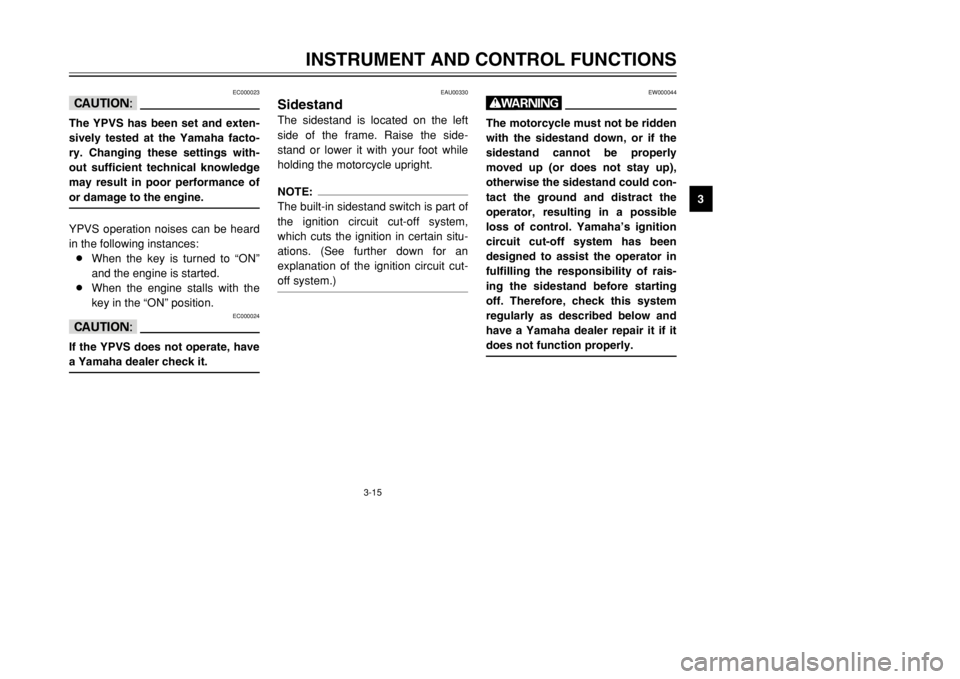
3-15
INSTRUMENT AND CONTROL FUNCTIONS
3
EC000023
cCThe YPVS has been set and exten-
sively tested at the Yamaha facto-
ry. Changing these settings with-
out sufficient technical knowledge
may result in poor performance of
or damage to the engine.YPVS operation noises can be heard
in the following instances:
8When the key is turned to “ON”
and the engine is started.
8When the engine stalls with the
key in the “ON” position.
EC000024
cCIf the YPVS does not operate, have
a Yamaha dealer check it.
EAU00330
SidestandThe sidestand is located on the left
side of the frame. Raise the side-
stand or lower it with your foot while
holding the motorcycle upright.NOTE:
The built-in sidestand switch is part of
the ignition circuit cut-off system,
which cuts the ignition in certain situ-
ations. (See further down for an
explanation of the ignition circuit cut-
off system.)
EW000044
wThe motorcycle must not be ridden
with the sidestand down, or if the
sidestand cannot be properly
moved up (or does not stay up),
otherwise the sidestand could con-
tact the ground and distract the
operator, resulting in a possible
loss of control. Yamaha’s ignition
circuit cut-off system has been
designed to assist the operator in
fulfilling the responsibility of rais-
ing the sidestand before starting
off. Therefore, check this system
regularly as described below and
have a Yamaha dealer repair it if it
does not function properly.
3MB-9-E8 6/13/01 10:55 AM Page 27
Page 31 of 96

4-1
EAU01114
PRE-OPERATION CHECKS
4The condition of a vehicle is the owner’s responsibility. Vital components can start to deteriorate quickly and unexpect-
edly, even if the vehicle remains unused (for example, as a result of exposure to the elements). Any damage, fluid leak-
age or loss of tire air pressure could have serious consequences. Therefore, it is very important, in addition to a thor-
ough visual inspection, to check the following points before each ride.
EAU03439
Pre-operation check list
ITEM CHECKS PAGE
Fuel•Check fuel level in fuel tank.
•Refuel if necessary.
•Check fuel line for leakage.3-5–3-7
2-stroke engine oil•Check oil level in oil tank.
•If necessary, add recommended oil to specified level.
•Check vehicle for oil leakage.3-8
Transmission oil•Check oil level in transmission case.
•If necessary, add recommended oil to specified level.6-10–6-12
Coolant•Check coolant level in reservoir.
•If necessary, add recommended coolant to specified level.
•Check cooling system for leakage.6-12–6-15
Front brake•Check operation.
•If soft or spongy, have Yamaha dealer bleed hydraulic system.
•Check lever free play.
•Adjust if necessary.
•Check fluid level in reservoir.
•If necessary, add recommended brake fluid to specified level.
•Check hydraulic system for leakage.3-5, 6-23, 6-24–6-26
Rear brake•Check operation.
•If soft or spongy, have Yamaha dealer bleed hydraulic system.
•Check fluid level in reservoir.
•If necessary, add recommended brake fluid to specified level.
•Check hydraulic system for leakage.3-5, 6-23–6-26
3MB-9-E8 6/13/01 10:55 AM Page 30
Page 35 of 96
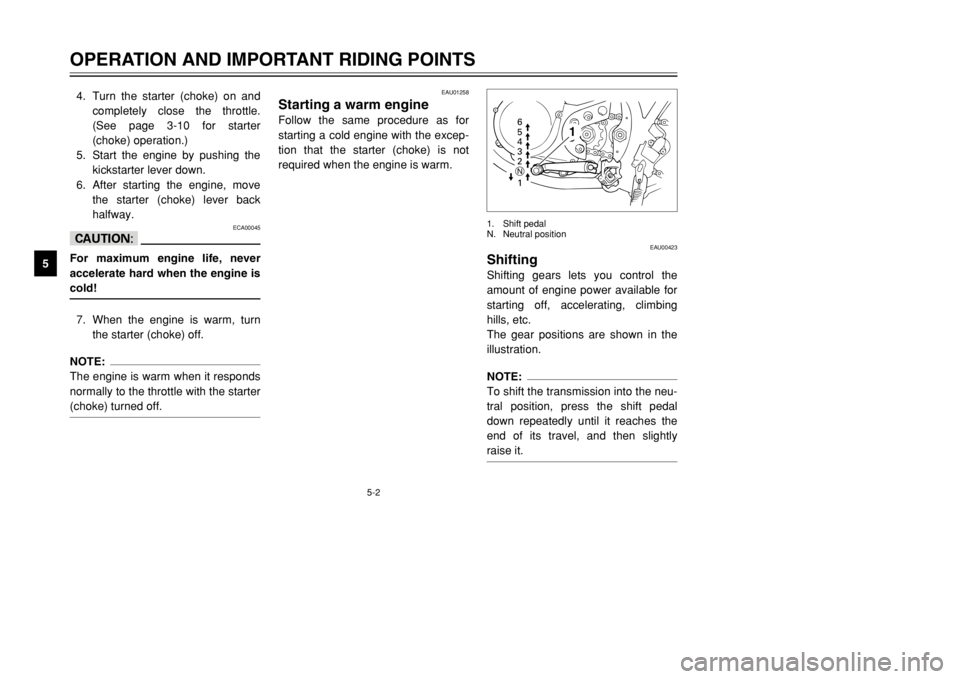
5-2
OPERATION AND IMPORTANT RIDING POINTS
54. Turn the starter (choke) on and
completely close the throttle.
(See page 3-10 for starter
(choke) operation.)
5. Start the engine by pushing the
kickstarter lever down.
6. After starting the engine, move
the starter (choke) lever back
halfway.
ECA00045
cCFor maximum engine life, never
accelerate hard when the engine is
cold!7. When the engine is warm, turn
the starter (choke) off.NOTE:
The engine is warm when it responds
normally to the throttle with the starter
(choke) turned off.
EAU01258
Starting a warm engineFollow the same procedure as for
starting a cold engine with the excep-
tion that the starter (choke) is not
required when the engine is warm.
EAU00423
ShiftingShifting gears lets you control the
amount of engine power available for
starting off, accelerating, climbing
hills, etc.
The gear positions are shown in the
illustration.NOTE:
To shift the transmission into the neu-
tral position, press the shift pedal
down repeatedly until it reaches the
end of its travel, and then slightly
raise it.
6
5
4
3
2
1 N
1
1. Shift pedal
N. Neutral position
3MB-9-E8 6/13/01 10:55 AM Page 34
Page 55 of 96

6-17
PERIODIC MAINTENANCE AND MINOR REPAIR
67. Pull the sponge material over the
frame.
8. Install the air filter element onto
the guide, and then tighten the
wing nut.
9. Insert the air filter element into
the case.
10. Install the air filter case cover by
installing the screws.
11. Install the panel.
EC000082
cC8Make sure that the air filter ele-
ment is properly seated in the
air filter case.
8The engine should never be
operated without the air filter
element installed, otherwise
the piston and/or cylinder may
become excessively worn.
EAU00632
Adjusting the engine idling
speedThe engine idling speed must be
checked and, if necessary, adjusted
as follows at the intervals specified in
the periodic maintenance and lubrica-
tion chart.
1. Start the engine and warm it up
for several minutes at 1,000–
2,000 r/min while occasionally
revving it to 4,000–5,000 r/min.NOTE:
The engine is warm when it quickly
responds to the throttle.2. Check the engine idling speed
and, if necessary, adjust it to
specification by turning the throt-
tle stop screw.
EAU00629
Adjusting the carburetorThe carburetor is an important part of
the engine and requires very sophisti-
cated adjustment. Therefore, most
carburetor adjustments should be left
to a Yamaha dealer, who has the
necessary professional knowledge
and experience. The adjustment
described in the following section,
however, may be serviced by the
owner as part of routine mainte-
nance.
EC000094
cCThe carburetor has been set and
extensively tested at the Yamaha
factory. Changing these settings
without sufficient technical knowl-
edge may result in poor perfor-
mance of or damage to the engine.
Recommended oil:
2-stroke engine oil
3MB-9-E8 6/13/01 10:55 AM Page 54
Page 66 of 96
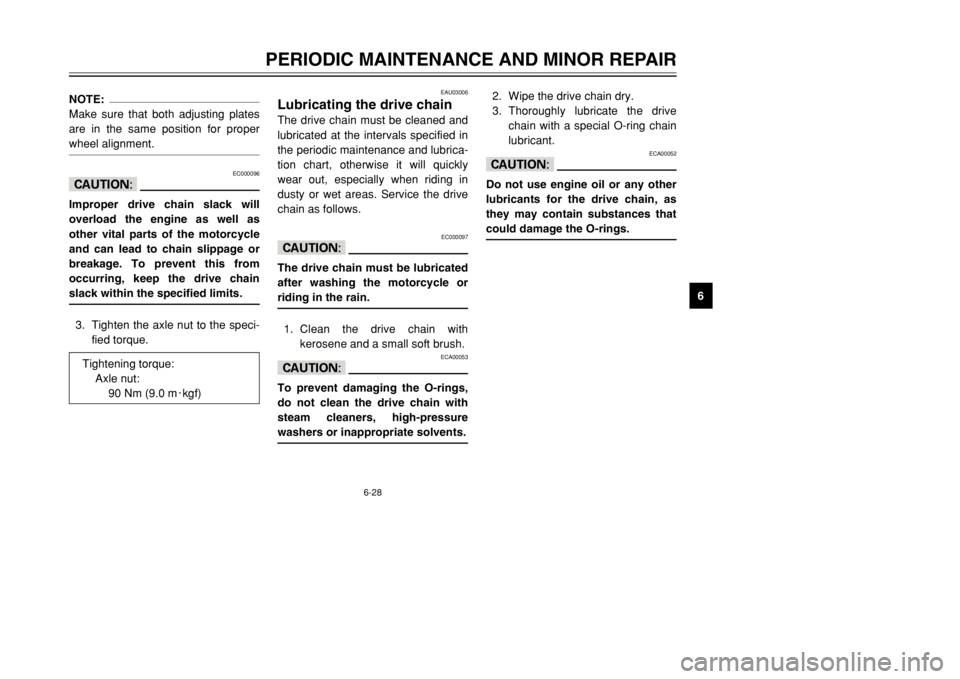
6-28
PERIODIC MAINTENANCE AND MINOR REPAIR
6
NOTE:
Make sure that both adjusting plates
are in the same position for proper
wheel alignment.
EC000096
cCImproper drive chain slack will
overload the engine as well as
other vital parts of the motorcycle
and can lead to chain slippage or
breakage. To prevent this from
occurring, keep the drive chain
slack within the specified limits.3. Tighten the axle nut to the speci-
fied torque.2. Wipe the drive chain dry.
3. Thoroughly lubricate the drive
chain with a special O-ring chain
lubricant.
ECA00052
cCDo not use engine oil or any other
lubricants for the drive chain, as
they may contain substances that
could damage the O-rings.
EAU03006
Lubricating the drive chainThe drive chain must be cleaned and
lubricated at the intervals specified in
the periodic maintenance and lubrica-
tion chart, otherwise it will quickly
wear out, especially when riding in
dusty or wet areas. Service the drive
chain as follows.
EC000097
cCThe drive chain must be lubricated
after washing the motorcycle or
riding in the rain.1. Clean the drive chain with
kerosene and a small soft brush.
ECA00053
cCTo prevent damaging the O-rings,
do not clean the drive chain with
steam cleaners, high-pressure
washers or inappropriate solvents.
Tightening torque:
Axle nut:
90 Nm (9.0 m0kgf)
3MB-9-E8 6/13/01 10:55 AM Page 65
Page 84 of 96
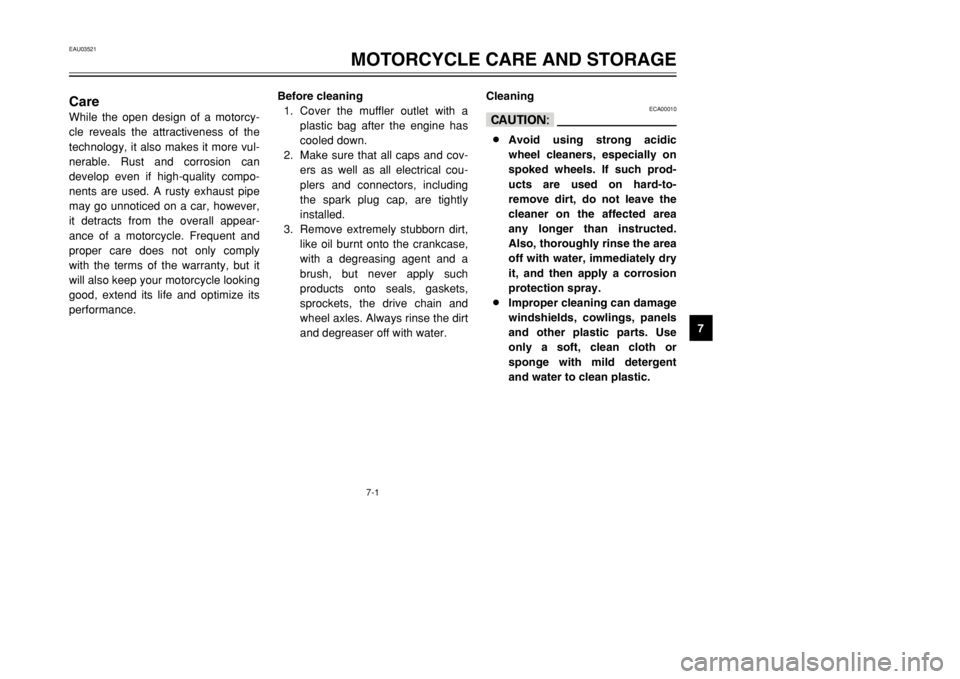
7-1
EAU03521
MOTORCYCLE CARE AND STORAGE
7
CareWhile the open design of a motorcy-
cle reveals the attractiveness of the
technology, it also makes it more vul-
nerable. Rust and corrosion can
develop even if high-quality compo-
nents are used. A rusty exhaust pipe
may go unnoticed on a car, however,
it detracts from the overall appear-
ance of a motorcycle. Frequent and
proper care does not only comply
with the terms of the warranty, but it
will also keep your motorcycle looking
good, extend its life and optimize its
performance.Before cleaning
1. Cover the muffler outlet with a
plastic bag after the engine has
cooled down.
2. Make sure that all caps and cov-
ers as well as all electrical cou-
plers and connectors, including
the spark plug cap, are tightly
installed.
3. Remove extremely stubborn dirt,
like oil burnt onto the crankcase,
with a degreasing agent and a
brush, but never apply such
products onto seals, gaskets,
sprockets, the drive chain and
wheel axles. Always rinse the dirt
and degreaser off with water.Cleaning
ECA00010
cC8Avoid using strong acidic
wheel cleaners, especially on
spoked wheels. If such prod-
ucts are used on hard-to-
remove dirt, do not leave the
cleaner on the affected area
any longer than instructed.
Also, thoroughly rinse the area
off with water, immediately dry
it, and then apply a corrosion
protection spray.
8Improper cleaning can damage
windshields, cowlings, panels
and other plastic parts. Use
only a soft, clean cloth or
sponge with mild detergent
and water to clean plastic.
3MB-9-E8 6/13/01 10:55 AM Page 83